Home / Blog /
How to Build Strong Care Team Collaboration with HIPAA Compliant Software

How to Build Strong Care Team Collaboration with HIPAA Compliant Software
Nobody who works in patient care wants to waste time or energy. There’s never enough of either.
Nor do we want to make mistakes. Because when we make a mistake, it affects someone’s health. The worst mistake can take a life.
Unfortunately, many patient care settings have evolved into inefficient operational systems that cause clinicians to waste time and energy, and to make mistakes. As a result, clinicians become frustrated, dissatisfied, and possibly even demoralized.
But the BEST health care operational systems support care team collaboration and empower us to work efficiently and accurately – to do our best, most gratifying work.
It’s time to modernize clinical communication
Your free guide to improved care team communication
|
 |
The Challenge: To Collaborate Effectively as a Care Team
The book, Patient Safety and Quality: An Evidence-Based Handbook for Nurses, summarizes the challenge well:
“In today’s health care system, delivery processes involve numerous interfaces and patient handoffs among multiple health care practitioners with varying levels of educational and occupational training. During the course of a 4-day hospital stay, a patient may interact with 50 different employees, including physicians, nurses, technicians, and others.
Effective clinical practice thus involves many instances where critical information must be accurately communicated. Team collaboration is essential. When health care professionals are not communicating effectively, patient safety is at risk for several reasons: lack of critical information, misinterpretation of information, unclear orders over the telephone, and overlooked changes in status.
Lack of communication creates situations where medical errors can occur. These errors have the potential to cause severe injury or unexpected patient death.”
Here are some specific medication issues caused by miscommunication, according to an analysis of medical malpractice claims:
- One in nine malpractice cases involved medication errors
- Medication categories that were especially problematic included analgesics, anticoagulants, antibiotics, and cardiovascular drugs
- Medication issues cause more patient deaths (32% of cases) than other malpractice areas (19% of cases)
And medication errors are just one area. Similar problematic areas exist throughout a patient’s hospital journey. Fortunately, communication is the common denominator, so a focus on helping care teams overcome ineffective communication and collaboration can have a far-reaching, positive improvement across a range of clinical scenarios and environments.
Technology to the Rescue?
Over the decades, technology has improved our ability to communicate and collaborate. We’ve seen:
- Pagers (1950)
- Multi-line phone systems (1960s)
- Electronic Health Record (EHR) systems (1969)
- Nurse call buttons (1979)
- Email (1990s)
Then the Apple iPhone hit the shelves in 2007. Eight years later, 84% of physicians were using Smartphones in their work.
There are significant benefits to texting with Smartphones in the healthcare setting:
- Everybody has one and knows how to use it, so there are no capital or training costs.
- People take them everywhere, so clinicians can send and receive messages wherever they can get a signal.
- Text messages are sent immediately, so there’s no waiting around for a callback.
- Healthcare communication apps can integrate with 3rd party systems to route alerts in real-time.

No Rescue Yet
But texting with Smartphones introduces a new set of problems.
- Health care workers are responsible for sharing patient information securely, but simple text messages are not encrypted and can be intercepted. These characteristics can easily lead to a data breach and could trigger extraordinary fines for the violation of HIPAA compliance.
- Simple text messages also violate HIPAA because they lack safeguards against sending Protected Health Information (PHI) to a wrong phone number and safeguards against indefinite storage on non-compliant servers.
- The sender doesn’t know the recipient received their message unless they receive a reply, which puts patient safety at risk.
- The sender has no easy way to discover which other clinicians are on the current care team, so they must rely on a separate system to identify care team members.
- Simple text messaging doesn’t automatically support many common workflows such as patient transport, patient discharge, and results notification and routing.
The Real Rescue: Clinical Communication & Collaboration Systems
Gartner uses the terms Clinical Communication and Collaboration (CC&C) and Care Team Collaboration (CTC) to describe HIPAA compliant software systems that fix communications problems and improve care team collaboration.
Let’s first look at how CC&C systems satisfy federal regulatory requirements. To understand this, we need to know what HIPAA requires in the context of software used by healthcare facilities.
The Health Insurance Portability and Accountability Act (HIPAA) defines PHI and how it must be protected. HIPAA compliance applies to two classes of health care organizations:
- Covered Entities: Providers and organizations that provide treatment, payment, and operations in healthcare. Example: a hospital.
- Business Associates: Vendors and organizations that have access to PHI and provider support to treatment, payment, or operations in healthcare. Example: a company that creates and sells HIPAA compliant software.
The U.S. Department of Health and Human Services (HHS) established the guidelines for how to create a HIPAA compliance program. We need to focus on three HIPAA rules:
- The Privacy Rule establishes standards for the use and disclosure of PHI. It affects only Covered Entities.
- The Security Rule sets security standards for the protection of PHI, including when a system holds or transfers it electronically. It affects both Covered Entities and Business Associates.
- The Omnibus Rule requires Business Associates to be HIPAA compliant. It also establishes standards for the Business Associate Agreement (BAA), which must be in place before Covered Entities can share PHI with Business Associates.
The HHS Office for Civil Rights (OCR) enforces the Privacy and Security Rules.
What does all this mean? Companies that market their CC&C solutions to Covered Entities are Business Associates who must comply with the Security Rule. This trait sets them apart from companies that offer standard SMS text messaging apps. You’ll need to establish a BAA with them before any PHI is shared.
“In relation to medical software applications, the term HIPAA compliant means that the app meets the technical and physical safeguards of the HIPAA Security Rule.” – HIPAA Journal
Now, some HIPAA compliant software reaches beyond HIPAA requirements to bring more PHI protection than is required by HIPAA. HITRUST CSF Certification is a “framework that provides organizations with a comprehensive, flexible and efficient approach to regulatory compliance and risk management.” This extra layer of security consists of 172 baseline controls across 19 domains. If your Business Associate is HITRUST CSF certified, you can expect to save up to $300,000 each year in audit requests and time spent completing internal assessments.
Finally, consider how you will secure the mobile devices used in your organization.

Better Collaboration
Regarding care team collaboration, below are six ways CC&C HIPAA compliant messaging solutions are superior to traditional SMS messaging. CC&C Systems:
- Integrate the complete clinical staff directory so users can easily contact any other care team member, whether there are 15 or 15,000.
- Integrate with staffing schedules so users can always contact the current care team members without pausing to look them up or wondering if they’re reaching the correct clinician.
- Can send PACS and other images, as well as videos, so consults can be processed wherever the consulting provider is, as long as they have a cell signal.
- Tell users when the recipient reads their message, so there’s no time or energy lost in wondering if the information got through.
- Systems integration with EHRs so results can be routed and reviewed as soon as they’re available.
- Have delivered dramatic results:
Conclusion: HIPAA Compliant Software Delivers Meaningful Benefits to Care Team Collaboration
Even though traditional, non-secure SMS texting is an improvement for care team collaboration, it’s not enough. On the other hand, Clinical Communication and Collaboration solutions fix every regulatory and communication shortfall of SMS texting:
- CC&C systems help healthcare facilities maintain compliance and raise no red flags in a HIPAA audit.
- They improve patient safety, patient outcomes, patient satisfaction, employee productivity, and employee satisfaction, as well as finances and public image. As demonstrated in this post, organizations that don’t implement are suffering from decreased staff productivity and satisfaction, decreased patient safety, and forfeiture of cost savings.
TigerConnect is a leader among HIPAA compliant software providers. With 99.99% uptime and HITRUST Certification, every organization considering a secure messaging implementation should include TigerConnect in its list of top contenders. Request a demo today!
Will O'Connor M.D., CMIO at TigerConnect
Will O’Connor, M.D. is the Chief Medical Information Officer at TigerConnect. As a physician executive with more than 20 years of healthcare experience, Will is a passionate advocate for rapid advancement across the healthcare industry.
Tags: Disclosure of Phi, HIPAA Compliance Software, Office for Civil, Covered Entities and Business, HIPAA Compliant, Risk Assessment, Compliance Software, Information Securely, HIPAA Security Rule, HIPAA Audit, Business Associate Agreements, Maintain Compliance, Federal Regulation, Health and Human Services, Data Breach, Department of Health, Protected Health Information, HIPAA Requires, HIPAA Compliance










